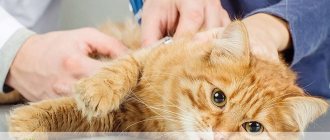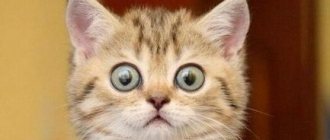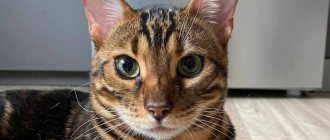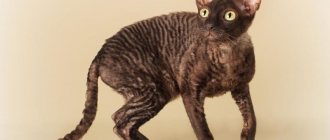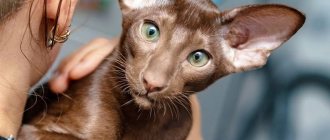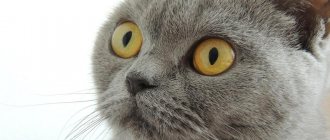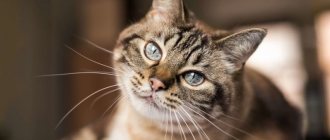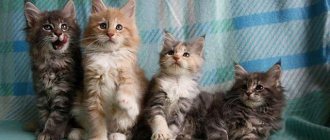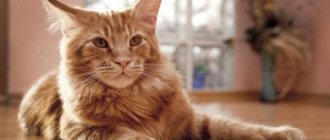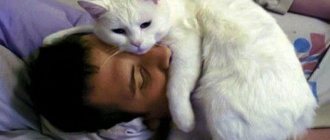Cats infected with toxoplasmosis often show no symptoms. In rare cases, cats develop lethargy, gastrointestinal problems, or even respiratory problems. Many cats will remain silent carriers their entire lives.
People can become infected with toxoplasmosis after handling cat litter containing the parasite and accidentally ingesting the microscopic cysts. They can also get it from eating contaminated meat.
Symptoms of toxoplasmosis in humans include fever, headache, lethargy and muscle pain. Toxoplasmosis may not actually cause any symptoms in people.
Warning: However, it can cause serious complications in pregnant women and people with weakened immune systems.
Intestinal parasites in cats
Many rodents are infected with common intestinal parasites such as roundworms. Intestinal parasites can cause diarrhea, vomiting and weight loss. Some intestinal parasites can be transmitted to other pets or people in the home.
If your cat goes outside or is known to have parasites, routine fecal testing for intestinal parasites is recommended. Your veterinarian may prescribe antiparasitic medications to deworm your cat. In addition, your cat will receive monthly heartworm and flea prevention with each dose.
What cat breeds are best at catching rats and mice?
Ratcatcher cats are naturally formed (native) breeds with bushy whiskers and large ears. These organs allow you to detect not only quiet sounds, but also vibrations, which are convenient for navigating in the dark. Another important point is the presence of a variegated color, with the help of which the cunning “mustaches” blend into the terrain and successfully deceive rodents.
INTERESTING!
All decorative breeds are completely devoid of hunting instinct. If you have hamsters or chinchillas, then feel free to get an exotic or ragdoll.
Maine Coon
Thanks to its impressive size, the Maine Coon can overcome not only a miniature vole, but also a mole. This pet is good at any time of the year. With the arrival of winter, it is protected by a thick undercoat, and additional tufts of hair on its paws make it easier to glide on ice.
The period of maximum motor activity of Maine Coons occurs in the first 5 years. Due to their innate passion, they pursue a discovered goal until victory. If a fly flies into the house, then in the course of catching it, the furry giant can turn everything around into real ruins.
“ More about the Maine Coon breed
Russian blue
Refined and graceful, Russian Blues have the most advantageous colors for a night ambush, and also know how to move silently and quickly. When living in an apartment, they hunt for insects flying inside and birds looming outside the window. Because of their enthusiasm, these cats often fall out of the window, so for safety reasons, anti-cat guards must be installed in all rooms.
Russian Blues do not trust strangers and try to avoid being seen in large crowds. They show their love only to members of their household, but subject to personal boundaries. Russian Blues do not like cuddling. Periodic exceptions are possible only in relation to children.
“ More about the Russian Blue breed
Siberian
With this fluffy rat catcher you can forget about the pest invasion forever. His skills are as good as those of a Maine Coon. The appearance is also similar. The “Siberian” also has a powerful body, muscular limbs, dense undercoat and tufts of wool on the paw pads.
“Siberians” are distinguished from Maine Coons by their character. They are much more playful and active. Because of their love for an active lifestyle, they require regular physical activity. If you have a fenced area, be sure to let your pet run around in the yard without a harness.
“ More about the Siberian cat breed
Kurilian Bobtail
Kurilian Bobtails are jacks of all trades, that is, masters of all trades. They are good not only at hunting small game, but also at fishing.
The activity of these cats depends on where they live. When free-ranging, they can spend hours tracking prey, fighting for territory with local animals, and exploring with interest all the hidden corners of nearby buildings.
By nature, Kuril Bobtails resemble dogs. They become very attached to their owners, love attention and are very enthusiastic about bringing a ball thrown to them.
An equally unique feature of these pets is fearlessness. To protect their family, they can enter into an unequal battle with a dog or other formidable opponent.
“ More about the Kurilian Bobtail breed
Cymric
Due to its compact body format, round muzzle, lack of tail and long coat, the Cymric is often called the “little bear.” When exterminating small pests, it uses its dexterous and mobile paws with tenacious claws. It is also helped by its longer hind limbs, which allow it to move by jumping like a rabbit.
Cymriks are not aggressive towards children and get along easily with other animals, including dogs. Despite their strong attachment to humans, representatives of this breed are famous for their autonomy and independence. Thanks to these qualities, they can be safely left alone while working.
British
Large “British” dogs look as aristocratic and noble as possible, so not everyone can imagine them in the role of a hunter. In fact, these plush “cheeks” even managed to leave their mark on history. Their ancestors were used by Roman legionnaires who arrived in the British Isles with the aim of seizing new territory. During the voyage, the cats taken on board the ship protected the holds with provisions from ship rats.
Modern “British” people are good-natured and unpretentious companions who love to lie on the sofa. Lying on the owner's lap is also acceptable, but provided that the pet itself was the initiator.
Despite the image of a lazy bumpkin, the “British” will never let a mouse sneak into the house. At the sight of prey, he immediately transforms into a wild beast, losing his usual restraint and sedateness.
“ More about the British Shorthair and British Longhair breeds
European Shorthair (Celtic)
European shorthairs can easily be confused with ordinary yard “murks”. Their main distinguishing feature is developed hunting skills, laid down from birth. If the European Shorthair shows indifference to the teaser rod and the birds outside the window, then the seller has cruelly deceived you and slipped you an ordinary mixed breed.
Representatives of this breed are quite modest and affectionate. They quickly become attached to their owner, but when showing feelings they behave too restrained. For this reason, the initiative should be taken independently, because otherwise the pet may decide that it is not loved.
Siamese
In hunting, “Siamese” are helped by long mustaches, large ears and a flexible body with developed muscles. Due to their peculiar coloration, it is easier for them to blend into the terrain at night, but this does not affect their skills in any way, so hunting during the day is also possible.
If you dream of an easy-going and quiet companion, then it’s better to take a “British”. Siamese cats are very capricious and demanding animals who love to chat. They use different tones and pitches to express their feelings, so with regular practice you can easily grasp the essence of the conversation and requests of your pet. The same thing applies in the opposite direction.
“ More about the Siamese cat breed
Nibelung
If budgies or aquarium fish live in your house, then it is better to refuse to buy a Nibelung. Unlike the “British”, he does not divide small animals into “us” and “strangers”. Because of this, not only an impudent wild rat, but also your favorite guppies or barbs can become prey for this handsome fluffy creature.
The Nibelung is a one-owner pet. The lucky one is easy to determine by the cat's behavior. If a Nibelung constantly pursues you and curls up on your lap on its own, then you can rest assured of its favor.
A busy work schedule is not suitable for keeping such a loving animal. If the owners are absent for a long time, you should get a playmate for your mustachioed pet.
Abyssinian
Strong and flexible, the Abyssinian is able to jump a distance of 6 times its body length. The cat's unusually long legs and developed muscle corset help in this.
INTERESTING!
The breed is named after its supposed homeland - Abyssinia, that is, present-day Ethiopia.
Despite their wild appearance, Abyssinians are balanced and intelligent pets who love children. They do not release their claws during joint games and are very patient with pranks on the part of their little owners.
The favorite pastime of these miniature cougars is patrolling. They detect all suspicious movements with their large ears, leaving no chance of slipping into the territory unnoticed.
“ More about the Abyssinian cat breed
Bengal
These domestic leopards were obtained by hybridization with wild Bengal cats, from which they acquired a passion for hunting and a love of water. All “Bengals” calmly tolerate water procedures and even dive into the bath on their own if they want to play around and frolic.
The friendliness of spotted pets varies by generation. The first 3 are the wildest and most unsociable. They are used for breeding and are categorically not recommended for families with children. Such animals will without hesitation rip a child for hugging too hard or accidentally stepping on a paw.
“ More about the Bengal cat breed
Turkish Angora
The Turkish Angora is the most unique representative of all the rat-catchers listed above. Its main feature is its snow-white color. All other color options provided by the standard are less common.
The main disadvantage of white is visibility. However, the birthplace of the Turkish Angora is Türkiye. This country has a lot of sand, and on the beaches its color is close to semolina. Only those with a snow-white or cream coat can hide against such a background.
Turkish Angoras love to ambush and hunt for toys scattered around the house. They also learn fetch very quickly and love to splash in the water, which makes water procedures much easier.
Plague bacteria in cats
Some rodents carry plague, an infection caused by the bacteria Yersinia pestis. 4 These are essentially the same bacteria that caused the infamous “Black Plague” of the Middle Ages. Plague is often spread by fleas, but cats can become infected by eating the meat of infected animals (often small mammals).
Cats infected with Yersinia pestis may experience lethargy, depression, loss of appetite, vomiting, diarrhea, cough, muscle soreness, and fever. The cat may develop swollen lymph nodes, lesions in the mouth, and weight loss.
Treatment includes the use of antibiotics and supportive care. The sooner treatment can be started, the higher the chances of survival.
People rarely become infected with the plague. When they do become infected, it is usually through a flea bite. Symptoms and treatment are relatively similar to those in cats.
Do genes influence a cat's ability to catch rodents?
The hunting instinct is truly inherited. Kittens born to mousecatchers inherit their parents' tendency to chase and catch small animals. But direct skill, that is, the effectiveness of hunting, develops through practice.
Noticing the pattern of inheritance of traits, breeders secured it through careful selection of individuals for breeding the breed. Thanks to experiments, they managed to achieve the preservation of genes in all subsequent generations.
INTERESTING!
The severity of the hunting instinct depends not only on the breed, but also on the color. The worst hunters are completely white cats.
Hantavirus infections
Several species of rodents are known to carry hantavirus. Cats can be infected with hantavirus but do not show any symptoms, so the virus is not harmful to them. Additionally, cats cannot transmit hantavirus to humans.
However, humans can be exposed through contact with infected rodents. 6 Although serious complications caused by hantavirus are uncommon in humans, exposure can lead to a serious illness called hantavirus pulmonary syndrome.
The meaning of appearance and the main characteristics of a hunter
At first glance, it is very difficult to determine how good a cat is at catching mice. But experts have identified several signs that indicate a successful hunter:
- muscular body;
- strong paws;
- powerful jaws;
- the outline of the skull resembles a triangle;
- ears are high, with tassels;
- bushy mustache;
- variegated coloring;
- short hair.
In addition, the cat must be active and have a good appetite. It is clear that it is almost impossible to detect the totality of all signs in one cat. But it is precisely these qualities that you should pay attention to when choosing a kitten that will catch mice.
Toxicity of rodenticides
Rodenticide is very toxic to cats. 7 Cats can eat rat poison placed in and around the house. Most often, cats become infected after fully or partially eating a rodent that has ingested rat poison. There are several types of rat poison, so symptoms and treatment may vary. Exposure to rodenticides is very dangerous even in small quantities.
Rodenticides can cause symptoms such as lethargy, gastrointestinal upset, pale gums, drunkenness, seizures, and more. If you suspect your cat has been exposed to rat poison, contact your veterinarian immediately. Aggressive treatment is often necessary.
